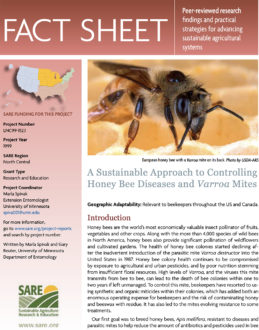Our goal is to breed honey bees, Apis mellifera, resistant to diseases and parasitic mites to reduce the amount of antibiotics and pesticides used in bee colonies, and to ensure that our breeding methods and stock are accessible to beekeepers everywhere.
We bred a line of bees for hygienic behavior, called the “MN Hygienic Line.” Hygienic behavior is the ability of bees to detect and remove diseased and mite-parasitized brood from the nest, and this behavior can be selectively bred into any line or race of honey bees. Our tests of the MN Hygienic Line in commercial apiaries demonstrated that they have good resistance to American foulbrood (a highly contagious and deadly bacterial disease of bee larvae) and chalkbrood (a less serious fungal disease of bee larvae).The hygienic line is partially resistant to the devastating mite, Varroa destructor.
In 2001, we began investigating the mechanism for the Suppression of Mite Reproduction trait (now called VSH) to determine how bees can reduce mite reproductive success. Our results demonstrate that bees bred for VSH are both hygienic and have some yet-unknown property associated with their brood that reduces the number of viable offspring the mites produce. Combining the VSH trait into the hygienic line, therefore, helped increase the degree of hygienic behavior in our line and added another factor that helps suppress mite reproduction.
Field trials in commercial apiaries have demonstrated that the MN Hygienic/VSH cross significantly reduces mite loads in colonies relative to the pure MN Hygienic Line and unselected lines of bees.
